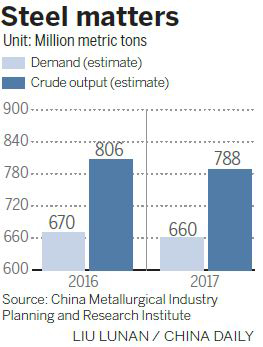Decline in demand to limit steel production
Iron and steel output in China in 2017 is expected to fall due to the shrinking demand of steel consumption industries and continuing efforts to cut overcapacity, according to a report.
Demand is estimated at 660 million metric tons, down 1.5 percent from the 2016 level (which is estimated at 667 million tons), said the report, released on Monday by the China Metallurgical Industry Planning and Research Institute.
Output of crude steel is estimated at 788 million tons, down 2.2 percent from 2016 (which is estimated at 806 million tons).
Most steel consumers will see falling demand, such as real estate construction (354 million tons, down 1.7 percent year-on-year) and shipbuilding (11.5 million tons, down 4.2 percent).
Two industries-automobile (56 million tons, up 3.7 percent year-on-year) and railway infrastructure (5 million tons, up 4.2 percent year-on-year)-will see rising demand.
Li Xinchuang, president of the institute, said that China will continue to cut outdated capacity and increase input in intelligent and green manufacturing next year.
"China has the most advanced steel manufacturing infrastructure in the world. Yet the small and unregulated steel smelters, which are producing substandard steel and engaging in high-polluting production, need to be eliminated," he said.
Statistics show that the crude steel output of the major 70 intermediate frequency furnace factories in 2015 was 110 million tons to 120 million tons, according to a report by csteelnews.com, a website focusing on the steel industry.
The goal of shedding overcapacity in 2016 is 45 million tons, which had been achieved at the end of October.
"We still have 55 million tons to 105 million tons capacity to be cut in the next four years, or 13.75 million tons to 26.25 million tons per year. It's going to be a long and bumpy journey," said Wang Guoqing, director of the Lange Steel Information Center.
























